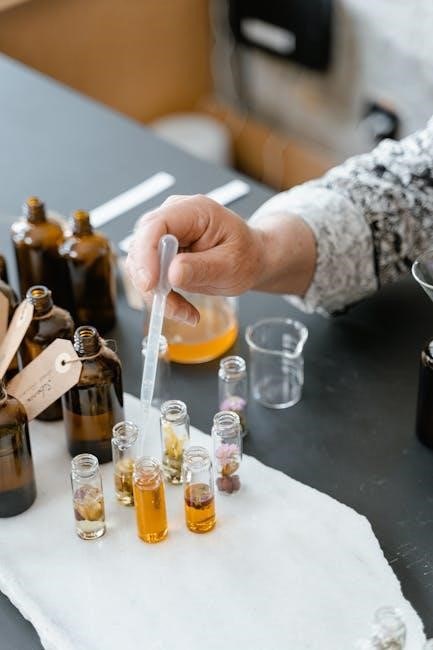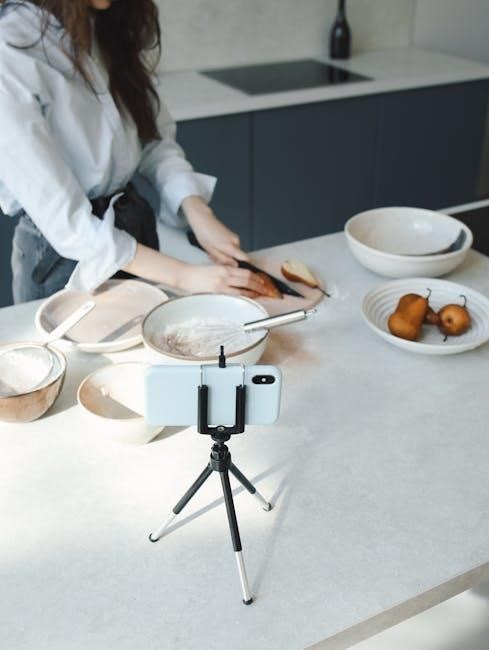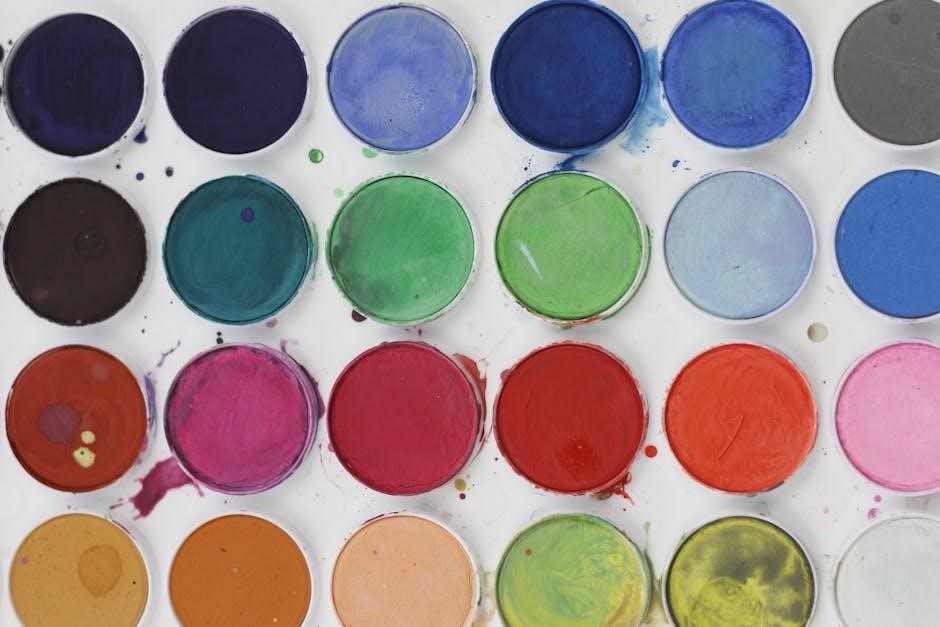
sermorelin 2mg mixing instructions
To properly prepare Sermorelin for injection, precise mixing is crucial. This section provides detailed instructions on reconstituting a 2mg vial of Sermorelin, ensuring the correct concentration for accurate dosage. Follow these steps carefully to achieve the desired outcome and maintain sterility throughout the process.
Sermorelin is a synthetic peptide analogue of growth hormone-releasing hormone (GHRH), playing a vital role in stimulating the pituitary gland to produce and release growth hormone (GH); Unlike direct GH supplementation, Sermorelin works by enhancing the body’s natural GH production, offering a potentially safer and more physiological approach. This characteristic makes it a popular choice for individuals seeking to improve their growth hormone levels.

Primarily, Sermorelin is utilized in the management of growth hormone deficiency, particularly in adults. Its use can lead to various benefits, including increased lean body mass, reduced body fat, improved energy levels, and enhanced sleep quality. The peptide’s mechanism of action ensures that GH release occurs in a pulsatile manner, mimicking the natural rhythm of GH secretion.
Understanding Sermorelin’s function and benefits is crucial before initiating treatment. Proper administration and dosage, as well as knowledge of potential side effects, are essential aspects of its use. Consulting with a healthcare professional ensures safe and effective implementation of Sermorelin therapy, tailored to individual needs and health conditions. This approach maximizes benefits while minimizing risks, promoting overall well-being.
Required Materials for Reconstitution
Before beginning the reconstitution process, it is essential to gather all necessary materials to ensure a smooth and sterile procedure. The primary component is, of course, the Sermorelin 2mg vial, containing the lyophilized (freeze-dried) peptide powder. Alongside this, you will need bacteriostatic water, which serves as the diluent to dissolve the Sermorelin.
Sterile syringes are crucial for accurately measuring and transferring the bacteriostatic water into the Sermorelin vial. Two syringes are typically recommended: a larger syringe (e.g., 3ml or 5ml) for drawing the bacteriostatic water and a smaller, finer syringe (e.g., insulin syringe) for administering the reconstituted Sermorelin.
Additionally, alcohol swabs are necessary for sterilizing the tops of both the Sermorelin and bacteriostatic water vials before drawing any liquid. Proper sterilization helps prevent contamination and ensures the safety of the injection. A mixing syringe will also be used to ensure the right amounts of liquid are combined. Finally, have a clean, flat surface to work on and a disposal container for used syringes and swabs.
Sterilization Procedures
Maintaining a sterile environment is paramount during the reconstitution process to prevent contamination and ensure the safety and efficacy of the Sermorelin. Before handling any materials, thoroughly wash your hands with soap and water, ensuring a minimum of 20 seconds of scrubbing to remove potential pathogens.
Next, prepare the vials for injection by sterilizing the rubber stoppers on both the Sermorelin vial and the bacteriostatic water vial. Using a fresh alcohol swab for each vial, vigorously wipe the rubber stopper in a circular motion, ensuring the entire surface is saturated with alcohol. Allow the alcohol to air dry completely for at least 30 seconds before proceeding.
This drying period is crucial, as it allows the alcohol to effectively kill any bacteria or contaminants present on the stopper. Avoid touching the sterilized stoppers with your fingers or any other non-sterile surface after wiping them down. If contamination occurs, repeat the sterilization process with a new alcohol swab. By adhering to these sterilization procedures, you minimize the risk of infection and maintain the integrity of the Sermorelin solution.

Calculating Bacteriostatic Water Dosage
Accurate calculation of bacteriostatic water dosage is essential for achieving the desired concentration of Sermorelin. For a 2mg vial of Sermorelin, the recommended amount of bacteriostatic water to add is typically 1ml. This ratio ensures a final concentration of 2mg of Sermorelin per 1ml of solution.
To determine the correct dosage, carefully consider the total volume of Sermorelin in the vial (2mg) and the desired concentration. In most cases, a 1:1 ratio of Sermorelin to bacteriostatic water is preferred, simplifying dosage calculations.
For instance, if you aim for a concentration of 2mg/ml, adding 1ml of bacteriostatic water to the 2mg vial will achieve this. This concentration allows for easy measurement and administration of the prescribed dose.
Always double-check your calculations and consult with a healthcare professional if you have any doubts or require a different concentration. Precise measurement is key to safe and effective Sermorelin administration. Remember, for every 2mg of Sermorelin, use 1ml of bacteriostatic water for optimal results.
Drawing Bacteriostatic Water into Syringe
After calculating the correct dosage of bacteriostatic water, the next step involves accurately drawing the liquid into a syringe. Start by ensuring the syringe is sterile and of appropriate size, typically a 1ml or 3ml syringe for small volumes.
Remove the protective cap from the syringe and the bacteriostatic water vial. Clean the rubber stopper of the vial with an alcohol swab to maintain sterility. Insert the needle of the syringe into the vial, making sure it penetrates the rubber stopper completely.
Invert the vial while holding the syringe firmly. Pull back the plunger of the syringe to draw the required amount of bacteriostatic water. Ensure there are no air bubbles in the syringe by gently tapping the side and pushing the air out.
Once you have drawn the correct amount, carefully remove the needle from the vial. Double-check the volume in the syringe to ensure accuracy. The syringe is now ready for injecting the bacteriostatic water into the Sermorelin vial.
Injecting Bacteriostatic Water into the Sermorelin Vial
Carefully inject the bacteriostatic water into the Sermorelin vial to reconstitute the lyophilized powder. Before injecting, ensure both the Sermorelin vial and the syringe containing the bacteriostatic water are ready. Wipe the top of the Sermorelin vial with an alcohol swab to maintain sterility.
Remove the cap from the syringe needle and gently insert the needle through the rubber stopper of the Sermorelin vial. Aim the needle towards the side of the vial to avoid directly hitting the powdered Sermorelin, which can cause foaming.
Slowly inject the bacteriostatic water into the vial, allowing it to gently run down the side. This method helps to preserve the integrity of the Sermorelin peptide. Once all the bacteriostatic water has been injected, carefully remove the syringe from the vial.
Avoid creating pressure or vacuum inside the vial. This ensures proper mixing and prevents any loss of the solution. The vial is now ready for the next step, which involves gently mixing the solution to fully dissolve the Sermorelin powder.
Mixing the Solution
After injecting the bacteriostatic water into the Sermorelin vial, the next crucial step is to thoroughly mix the solution. Gentle mixing ensures the Sermorelin powder completely dissolves into the bacteriostatic water, creating a homogenous solution ready for accurate dosing. Avoid shaking the vial vigorously, as this can damage the Sermorelin peptide.
Instead, gently swirl the vial in a circular motion for several minutes. This allows the bacteriostatic water to gradually interact with the lyophilized Sermorelin, dissolving it without causing excessive foaming or degradation. Continue swirling until no visible particles of powder remain at the bottom of the vial.
Inspect the solution carefully to ensure it is clear and free of any undissolved particles. If any powder remains, continue swirling gently until it fully dissolves. Patience is key during this step to ensure the integrity and effectiveness of the Sermorelin.
Once the solution is completely mixed and clear, it is ready for use. Always remember to refrigerate the reconstituted Sermorelin to maintain its stability and potency. Proper mixing is essential for accurate dosing and optimal results.
Determining Final Concentration
After successfully mixing the Sermorelin solution, determining the final concentration is essential for accurate dosage calculation. This step involves understanding the relationship between the amount of Sermorelin powder and the volume of bacteriostatic water used for reconstitution. Knowing the final concentration allows you to precisely measure the required dose for each injection.
For a 2mg vial of Sermorelin, if you’ve added 1ml of bacteriostatic water, the resulting concentration will be 2mg per ml. This means that every 0.1ml of the solution contains 0.2mg of Sermorelin. Similarly, if you used 2ml of bacteriostatic water, the concentration would be 1mg per ml, with each 0.1ml containing 0.1mg of Sermorelin.
Understanding these calculations is crucial for administering the correct dosage. Always double-check your measurements and calculations to avoid errors. Accurate concentration determination ensures you receive the intended therapeutic benefits from your Sermorelin treatment.
Refer to your healthcare provider’s instructions or a dosage calculator to confirm the appropriate volume to inject based on your prescribed dose and the final concentration of your reconstituted Sermorelin solution.
Calculating the Correct Dosage
Once you’ve determined the final concentration of your reconstituted Sermorelin solution, the next crucial step is calculating the correct dosage to administer. This calculation depends on your prescribed dose, typically given in micrograms (mcg) or milligrams (mg), and the concentration of your solution, usually expressed as mg/ml.
To calculate the required volume for injection, divide your prescribed dose by the concentration of the solution. For example, if your prescribed dose is 300 mcg (0.3 mg) and your solution has a concentration of 2 mg/ml, you would divide 0.3 mg by 2 mg/ml, resulting in 0.15 ml. This means you need to inject 0.15 ml of the solution to get your prescribed dose.

Using an insulin syringe, which is calibrated in units (typically 100 units per ml), you can easily measure small volumes. In the previous example, 0.15 ml would be equivalent to 15 units on an insulin syringe. Always double-check your calculations and measurements to ensure accuracy.
Consult your healthcare provider or a qualified professional if you have any doubts or questions about dosage calculations. They can provide personalized guidance based on your specific needs and circumstances, ensuring you receive the optimal benefit from your Sermorelin treatment.
Administering the Injection
With your dosage accurately calculated and drawn into the syringe, you’re ready to administer the Sermorelin injection. Sermorelin is typically administered subcutaneously, meaning it’s injected into the fatty tissue just beneath the skin. Common injection sites include the abdomen, thigh, or upper arm. Rotate injection sites to prevent irritation.
Before injecting, cleanse the chosen injection site with an alcohol swab, allowing it to dry completely. Pinch the skin around the injection site to create a small fold. Insert the needle at a 45 to 90-degree angle, depending on the thickness of your skin and the length of the needle.
Once the needle is in place, release the pinched skin and slowly inject the solution. Avoid injecting too quickly, as this can cause discomfort. After injecting, withdraw the needle gently and apply a clean cotton ball or gauze pad to the injection site. Do not massage the area.
Dispose of the used syringe and needle properly in a sharps container. Never reuse syringes or needles. Monitor the injection site for any signs of redness, swelling, or irritation. If you experience any adverse reactions, contact your healthcare provider immediately.
Storage Instructions Before Reconstitution
Proper storage of Sermorelin before reconstitution is essential to maintain its integrity and effectiveness. Unreconstituted Sermorelin should be stored in a cool, dry place, away from direct sunlight and heat. The ideal storage temperature is typically between 2°C to 8°C (36°F to 46°F), which can be achieved by storing it in a refrigerator.
Ensure that the vial is tightly sealed to prevent moisture from entering. Avoid storing Sermorelin in areas where it may be exposed to extreme temperature fluctuations, such as near a window or in a bathroom. Keep the medication out of reach of children and pets.
Always check the expiration date on the vial before use. Do not use Sermorelin if it has expired, as its potency may be compromised. If you are unsure about the proper storage conditions, consult your pharmacist or healthcare provider. Following these storage guidelines will help ensure that your Sermorelin remains stable and effective until it is ready to be reconstituted.
Remember to keep detailed records of when you received your medication and when it expires to ensure that you’re using it within the recommended timeframe.
Storage Instructions After Reconstitution
Once Sermorelin has been reconstituted with bacteriostatic water, proper storage is crucial to maintain its stability and effectiveness. After reconstitution, Sermorelin should be stored in the refrigerator at a temperature between 2°C to 8°C (36°F to 46°F). This helps to slow down the degradation of the peptide and prolong its shelf life.
Ensure the vial is tightly sealed to prevent contamination and maintain sterility. Avoid freezing the reconstituted solution, as this can damage the peptide structure and reduce its efficacy. It is recommended to use the reconstituted Sermorelin within a specific timeframe, typically up to 90 days, as indicated by the manufacturer or healthcare provider.
Always check the appearance of the solution before each use. If you notice any cloudiness, discoloration, or particulate matter, discard the vial and do not use the medication. Keep the reconstituted Sermorelin out of direct sunlight and away from heat sources.
Proper storage after reconstitution is essential to ensure that you are receiving the full therapeutic benefits of Sermorelin. Always follow the specific storage instructions provided by your healthcare provider or pharmacist.
Consulting a Healthcare Provider
Before initiating Sermorelin therapy, it is imperative to consult with a qualified healthcare provider. This consultation is crucial for several reasons, including a thorough evaluation of your medical history, current health status, and any existing medical conditions. A healthcare provider can determine if Sermorelin is appropriate for you based on your individual needs and circumstances.
They can also provide personalized instructions on how to properly mix, administer, and store Sermorelin; This ensures that you are using the medication safely and effectively. Furthermore, a healthcare provider can monitor your progress and adjust the dosage as needed to optimize results and minimize potential side effects.
Discuss any concerns or questions you may have about Sermorelin with your healthcare provider. They can provide you with accurate information and guidance to make informed decisions about your health. Self-treating with Sermorelin without consulting a healthcare provider can be risky and may lead to adverse outcomes.

Always prioritize your health and well-being by seeking professional medical advice before starting any new medication or treatment regimen. Consulting a healthcare provider is an essential step in ensuring the safe and effective use of Sermorelin.